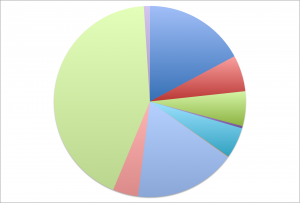“I’ll look to like, if looking liking move,” Shakespeare’s Juliet declares in the semi-eponymous classic play. Today, of course, “liking” on the Internet has nothing to do with star-crossed lovers, but whether they’re your irrational first love or the one who’s simply grown on you, the presidential candidate you choose is one you take a leap with and trust to run your country. Facebook “likes” are a great indicator of a candidate’s momentum, and because I have my priorities wrong, I have been looking at candidates’ pages and number of likes and assembled some data that HPReaders may find interesting. Some of the trends are predictable, others, not so much.
What’s interesting about these numbers is how much they say about a campaign’s staying power. It’s valuable to see not only how many “likes” a candidate already has, but the pace at which they increase, both in terms of raw numbers and percentages. We’re looking at an approximately two-week period with these numbers, from June 25 to July 9, 2011. I’m also shamelessly ignoring the concept of significant figures, and these numbers change in minutes and the numbers were not taken at a precise time – but work with me here.
Here are my non-scientific conclusions. (Data follows below)
Bachmann can win Iowa. The greatest net gain in likes was Bachmann’s, easily overcoming Facebook powerhouse Palin. It looks like she’s gaining a lot of steam thanks to media coverage – both positive and negative – most recently by signing a homophobic, possibly racist “pro-family” pledge to win an endorsement.
Palin can’t keep waiting. There was a point where many were saying Palin’s entrance would transform the race, and as the Queen of Politweets, she had the following and presence to enter whenever she wanted. Now, however, with Palin’s net rate of Facebook like increases having fallen significantly behind Bachmann’s, and her slipping in the polls which still list her, Palin probably needs to get in soon to convince people she’s still serious. And if she doesn’t run, she should probably say so soon before breaking the hearts of all those people working hard for her in Iowa.

Relative share of "likes" by candidate (clockwise from dark blue): Bachmann, 17%; Cain, 6%; Gingrich, 6%; Huntsman, 0%; Johnson, 5%; Karger, 0%; Paul, 17%; Pawlenty, 4%; Romney, 43%; Santorum, 1%; McCotter, 0%.
Romney is the frontrunner – but he’s not gaining traction. The polls – and Facebook data – make it look clear that
Romney, with over a million supporters, is way ahead of the declared pack. But take a look at these numbers –Romney’s percentage increase in likes was 1.4%, far behind Bachmann’s 10.5%. These aren’t winning numbers, and Romney needs to keep working to get more supporters.
Gingrich won’t win. While I’m not one to tell a candidate when to quit, it seems rather obvious that this isn’t a good use of his time. His campaign implosion notwithstanding, the former Speaker gained less than 600 likes in two weeks. For a candidate who claimed he wanted to run a social-media-heavy campaign, these numbers are disheartening. He began the two weeks slightly ahead of Cain, but Cain, who gained over 5,500 likes, easily surpassed him. Pawlenty is running pretty flat, too, with another under-1,000 like gain.
Huntsman has potential. But not too much. Huntsman easily won as far as percentage gains were concerned, his numbers surging by 13.8%. However, that only amounted to a jump from slightly over 8,000 to a bit over 9,000 likes, which makes it look far less impressive by comparison. Is there room for two Utahns in this race?
Perry has potential. Perry, who had earlier denied his interest in running, seems to be undergoing the classical politician’s change of heart, and he has been picking up more likes than Gingrich, Huntsman, Johnson, Karger, Pawlenty, and Santorum. This says something – if Republicans decide America is ready for another president from Texas, Perry could change the dynamic of this race.
Libertarians like Facebook. Congressman Paul does well on Facebook, with about as many likes as Bachmann, making him third out of declared candidates. More surprisingly, former governor Gary Johnson has over 20,000 more likes than Pawlenty, at around 126,000.
So, I hope you found these numbers interesting. Here’s the data (declared candidates are in bold):
| 25-Jun-11 | 9-Jul-11 | Net Change | %Change | |
| Michele Bachmann | 374,657 | 414,102 | 39,445 | 10.528% |
| Herman Cain | 142,135 | 147,815 | 5,680 | 3.996% |
| Newt Gingrich | 141,479 | 142,054 | 575 | 0.406% |
| Jon Huntsman | 8,007 | 9,114 | 1,107 | 13.825% |
| Gary Johnson | 124,031 | 126,466 | 2,435 | 1.963% |
| Fred Karger | 1,906 | 2,047 | 141 | 7.398% |
| Ron Paul | 403,525 | 413,474 | 9,949 | 2.466% |
| Tim Pawlenty | 102,330 | 103,054 | 724 | 0.708% |
| Mitt Romney | 1,018,064 | 1,031,859 | 13,795 | 1.355% |
| Rick Santorum | 22,789 | 23,374 | 585 | 2.567% |
| Thad McCotter | – | 1,012 | 1,012 | N/A |
| John Bolton | 6,260 | 6,311 | 51 | 0.815% |
| Sarah Palin | 3,161,768 | 3,181,717 | 19,949 | 0.631% |
| Rick Perry | 65,402 | 69,182 | 3,780 | 5.780% |
| Buddy Roemer | 1,723 | 1,782 | 59 | 3.424% |
